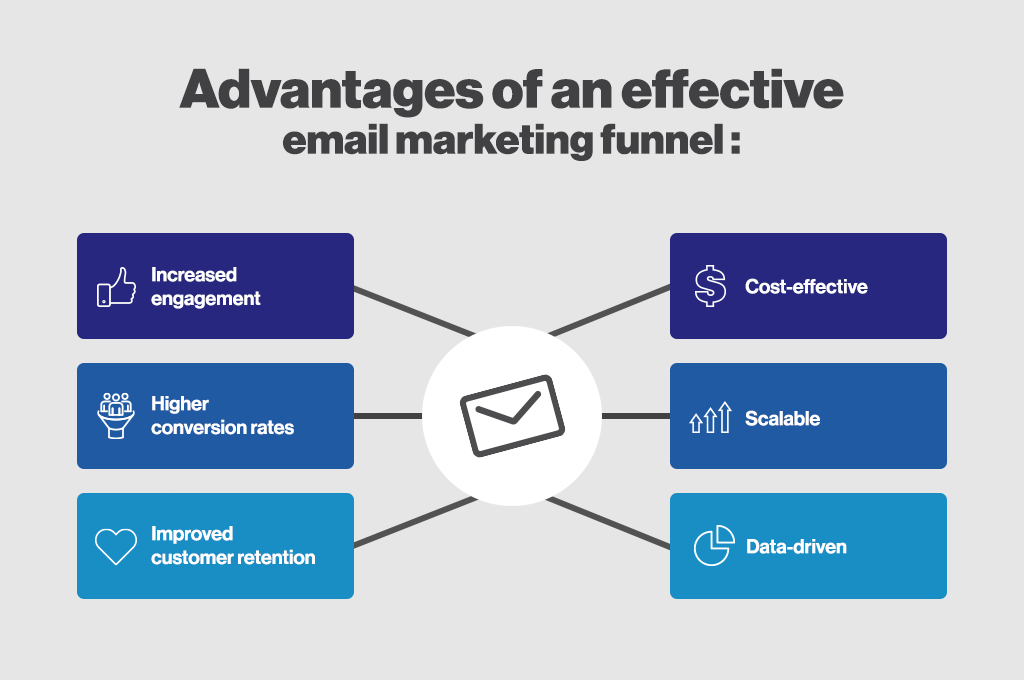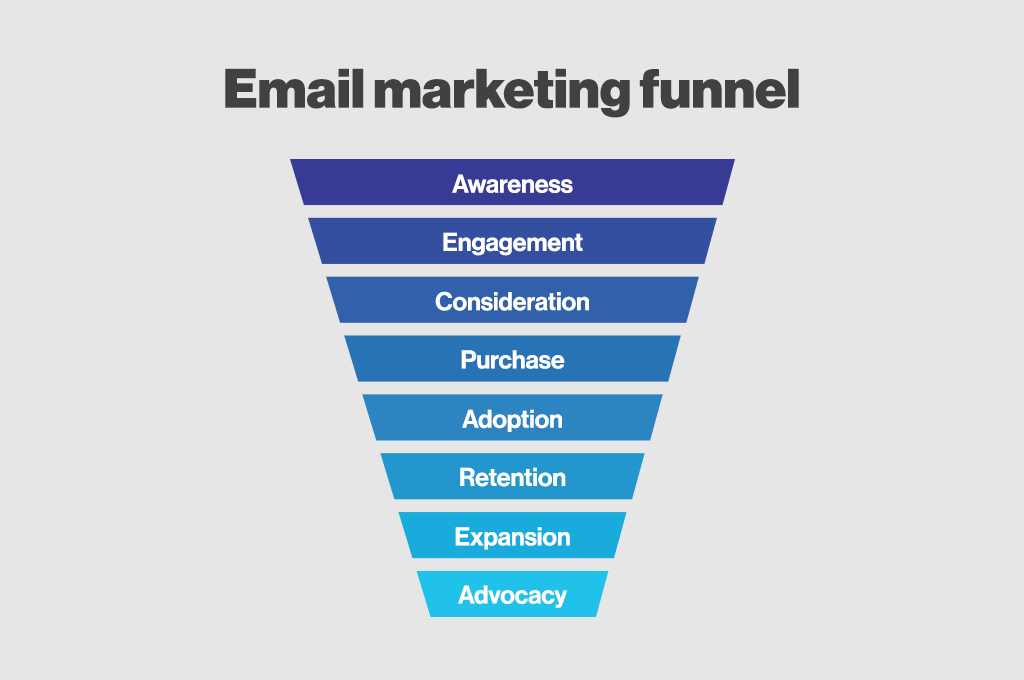Email marketing funnels is about visualizing the journey a user takes from initial contact to the stage when they finally become your customer.
Well-targeted content and properly timed emails will help to make your visitors’ experience even more efficient and satisfying. Understanding the importance of each stage of the marketing funnel will contribute to better realizing how to help your customer in the decision-making process while educating and building a strong relationship with them along the way.
In this article, we’ll walk you through the steps to organize your email marketing funnel and help you build your campaign successfully for your target audience.
What is Email Marketing Funnel?
Before we start talking about the email marketing funnel, let’s discuss what email marketing is. So, email marketing is a digital marketing strategy that involves sending commercial messages to a targeted audience via email. The purpose of email marketing is to promote a business, its products, and its services, and to build a relationship with its customers. It is an effective and cost-efficient way to communicate with users, generate leads, and drive sales.
One of the primary benefits of email marketing is its ability to reach a large audience quickly. With the right targeting and messaging, businesses can connect with their customers and prospects in a personalized and meaningful way, building trust and loyalty over time.
Email marketing is one of the most successful ways to engage with your audience, and drive sales. But, to maximize its potential, you need to learn how to effectively market your product and create professional emails to make your marketing funnel work for you.
Now let us get down to the definition and benefits of the email marketing funnel: This is a process of converting website visitors into loyal customers. The funnel itself is a series of email campaigns, where you guide your users through the stages of awareness, engagement, consideration, purchase, adoption, retention, expansion, and word-of-mouth advocacy.
An effective email marketing funnel can offer numerous advantages for your business:

Increased engagement
By sending targeted and relevant emails to your subscribers, you can increase their engagement with your brand. This can lead to higher open rates, click-through rates, and overall engagement with your content.
Higher conversion rates
An email marketing funnel is designed to guide subscribers toward a specific action, such as making a purchase or signing up for a service. By providing value and building trust with your subscribers, you can increase your conversion rates and generate more revenue for your business.
Improved customer retention
By staying in touch with your subscribers through a series of automated emails, you can improve your customer retention rates. This can lead to more repeat purchases and loyalty.
Cost-effective
Compared to other forms of marketing, email marketing can be very cost-effective. Once you have set up your profitable email marketing funnel, you can continue to engage with your subscribers and generate revenue without incurring additional costs.
Scalable
An email marketing funnel is scalable, which means that it can be automated and scaled up as your business grows. This allows you to reach a larger audience without increasing your workload or marketing expenses..
Data-driven
An effective email marketing funnel is data-driven, which means that you can track and analyze your performance metrics to make informed decisions. This can help you optimize your strategy and improve your results over time.
Email Marketing Funnel: 8 Stages
There are 8 stages of a sales funnel allowing you to optimize your email campaigns for each particular stage.

1. Awareness
The first stage of the email marketing funnel is awareness. At this stage, the goal is to introduce your brand and products to potential customers who may not be familiar with your business. You can achieve this by using lead magnets, such as free ebooks, whitepapers, or webinars, to entice people to sign up for your email list.
Your emails should focus on providing value and building a relationship with your subscribers. You can also provide links to the articles from knowledge base to help users learn more about your product.
2. Engagement
Once you have built a list of subscribers, the next stage is to engage with them. At this stage, you should be sending emails that provide more in-depth information about your products or services. You can also use surveys or quizzes to gather more information about your subscribers’ preferences and interests.
Or you can also redirect subscribers to your social media profiles as it can increase engagement and boost social media presence. The goal is to keep your subscribers engaged and interested in your brand.
3. Consideration
At the consideration stage, your subscribers are actively considering whether to make a purchase. Your emails should focus on building trust and addressing any concerns or objections your subscribers may have. You can provide social proof by including customer reviews and testimonials. You can also offer discounts or promotions to incentivize purchases.
4. Purchase
The purchase stage is where your subscribers become paying customers. At this stage, your emails should focus on providing a seamless buying experience and addressing any issues or questions that may arise during the purchase process.
You can also use order confirmation and shipping confirmation emails to keep your customers informed and engaged.
5. Adoption
After a customer makes a purchase, the next stage is adoption. At this stage, your goal is to help your customers get the most out of their purchases. You can provide tutorials, tips, and resources to help them use your products effectively. You can also encourage them to leave reviews and share their experiences with others.
6. Customer Retention and Loyalty
Customer retention and loyalty are critical to the long-term success of your business. At this stage, your emails should focus on keeping your customers engaged and loyal to your brand.
Offer your clients exclusive promotions or discounts to reward them; use email surveys to gather feedback and address any issues that may arise. Be attentive to your customers: make sure you congratulate them on their birthdays and other important events.
7. Expansion
The expansion stage is where you encourage your customers to make additional purchases or upgrade to premium services. Your emails should focus on upselling and cross-selling.
You can also offer personalized product recommendations based on your customer’s past purchases and preferences.
8. Advocacy
The final stage of the email marketing funnel is advocacy. At this stage, your goal is to turn your satisfied customers into brand ambassadors. You can encourage your customers to leave reviews and share their experiences on social media. You can also offer referral rewards to incentivize your customers to refer your offer to their friends and family.
Organizing your Email Marketing Funnel in 4 steps
Here are the four steps for marketers to organize email marketing funnel effectively:
1. Organizing clean email lists
Your email lists should be clean, segmented, and targeted. It is essential to verify your email list and remove inactive subscribers who block unwanted emails, duplicated email addresses, and bounced emails. By segmenting your email lists, you can personalize your messaging and create more effective campaigns. You can also run an email deliverability test to make sure that your emails get to the inboxes.
2. Triggered emails
Triggered emails are automated emails that are triggered by a specific action or behavior of your customers. Triggered emails can be personalized and relevant, and they can increase engagement and conversions. Your emails can be based on cart abandonment, website browsing, and previous purchases.
3. Learn your target audience
It is essential to understand your target audience to create effective email campaigns. By analyzing your target audience’s demographics, behavior, interests, and preferences, you can create relevant and personalized messaging. You can learn about your target audience by conducting surveys, analyzing your website data, and tracking your email campaign results.
4. Define your triggers
By defining your triggers, you can create more relevant and effective campaigns, using effective marketing tools. Use personalization, be brief, make a clear call to action, ensure each email has adequate value, and do not forget to run tests to check which strategy works the best.
Remember: When organizing an email marketing funnel, the first step is to make sure all your employees can cooperate and work together effectively. For example, you can choose from the variety of alternatives to Monday.com and find the right collaboration software that improves team collaboration and therefore boosts team productivity and results.
Conclusion
In conclusion, organizing your email marketing funnel is crucial for success. By following these steps, you can create effective campaigns, build relationships with your customers, and drive sales. Whether you’re targeting regular customers or organizations like SMEs, NPOs, entertainment companies, or government companies, you can use these steps to build successful email marketing campaigns.
A properly organized and planned email marketing funnel will contribute to nurturing leads, raising your brand awareness, and winning the hearts of your customers.

About the author:
Julia Serdiuk is an Outreach Specialist at HelpCrunch, all-in-one customer service software. She is a bookworm and yoga enthusiast who appreciates life in its various manifestations.
